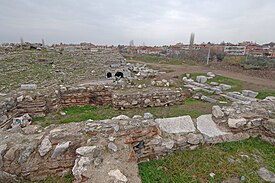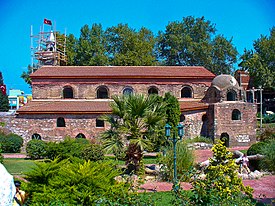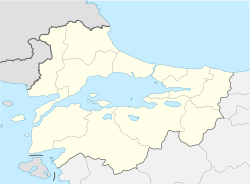
Back Nicea Afrikaans نيقية Arabic نيقيا ARZ Нікея BE-X-OLD Никея Bulgarian Nikaia Breton Nikeja BS Nicea Catalan Nikaia Czech Νίκαια (Βιθυνία) Greek
Νίκαια (Ancient Greek) | |
Ruins of the Roman Theatre Byzantine-era city wall • Lefke Gate Orhan Mosque (formerly Hagia Sophia) | |
| Alternative name | Nikaia |
|---|---|
| Location | İznik, Bursa Province, Turkey |
| Region | Bithynia |
| Coordinates | 40°25.74′N 29°43.17′E / 40.42900°N 29.71950°E |
| Type | Settlement |
| Area | 145 ha (360 acres)[1][2] |
| History | |
| Builder | Antigonus I Monophthalmus[3] |
| Founded | c. 316[4][5][6] – 315[7][8] BC |
| Cultures | Ancient Greek, Roman, Byzantine, Ottoman |
| Events | First and Second Council of Nicaea |
Nicaea (also spelled Nicæa or Nicea, /naɪˈsiːə/ ny-SEE-ə;[9] Latin: [niːˈkae̯.a]), also known as Nikaia (‹See Tfd›Greek: Νίκαια, Attic: [nǐːkai̯a], Koine: [ˈnikεa]), was an ancient Greek city in the north-western Anatolian region of Bithynia[4][10][11] that is primarily known as the site of the First and Second Councils of Nicaea (the first and seventh Ecumenical councils in the early history of the Christian Church), the Nicene Creed (which comes from the First Council), and as the capital city of the Empire of Nicaea following the Fourth Crusade in 1204, until the recapture of Constantinople by the Byzantines in 1261. Nicaea was also the capital of the Ottomans from 1331 to 1335.
The ancient city is located within the modern Turkish city of İznik (whose modern name derives from Nicaea's), and is situated in a fertile basin at the eastern end of Lake Ascanius, bounded by ranges of hills to the north and south. It is situated with its west wall rising from the lake itself, providing both protection from siege from that direction, as well as a source of supplies which would be difficult to cut off. The lake is large enough that it could not be blockaded from the land easily, and the city was large enough to make any attempt to reach the harbour from shore-based siege weapons very difficult.
The ancient city is surrounded on all sides by 5 kilometres (3 mi) of walls about 10 metres (33 ft) high. These are in turn surrounded by a double ditch on the land portions, and also included over 100 towers in various locations. Large gates on the three landbound sides of the walls provided the only entrance to the city. Today, the walls have been pierced in many places for roads, but much of the early work survives; as a result, it is a tourist destination.
- ^ Intagliata, Emmanuele; Barker, Simon J.; Christopher, Courault, eds. (2020). City Walls in Late Antiquity: An empire-wide perspective. Oxbow Books. p. 83. ISBN 9781789253672.
- ^ Pascual, José; Papakonstantinou, Maria-Foteini, eds. (2013). Topography and History of Ancient Epicnemidian Locris. BRILL. p. 97. ISBN 9789004256750.
- ^ Chamoux, François (2008). Hellenistic Civilization. John Wiley & Sons. p. 178. ISBN 9780470752050.
- ^ a b Haverfield, Francis J. (2020). Ancient Town-Planing. BoD – Books on Demand. p. 27. ISBN 9783752307689.
- ^ Dumper, Michael (2007). Dumper, Michael; Stanley, Bruce E. (eds.). Cities of the Middle East and North Africa: A Historical Encyclopedia. ABC-CLIO. p. 194. ISBN 9781576079195.
- ^ April, Wilfred (2018). Culture and Identity. BoD – Books on Demand. p. 26. ISBN 9781789230406.
- ^ Coleman-Norton, Paul R. (2018). Roman State & Christian Church Volume 1: A Collection of Legal Documents to A.D. 535. Wipf and Stock Publishers. p. 126. ISBN 9781725255647.
- ^ Cite error: The named reference
Britannicawas invoked but never defined (see the help page). - ^ "Nicaea". Collins English Dictionary. HarperCollins. Retrieved 2022-12-11.
- ^ D'Agostini, Monica; Anson, Edward M.; Pownall, Frances, eds. (2020). Alexander's Veterans and the Early Wars of the Successors. Oxbow Books. ISBN 9781789254990.
- ^ Roisman, Joseph (2012). Alexander's Veterans and the Early Wars of the Successors. University of Texas Press. p. 237. ISBN 9780292735965.





